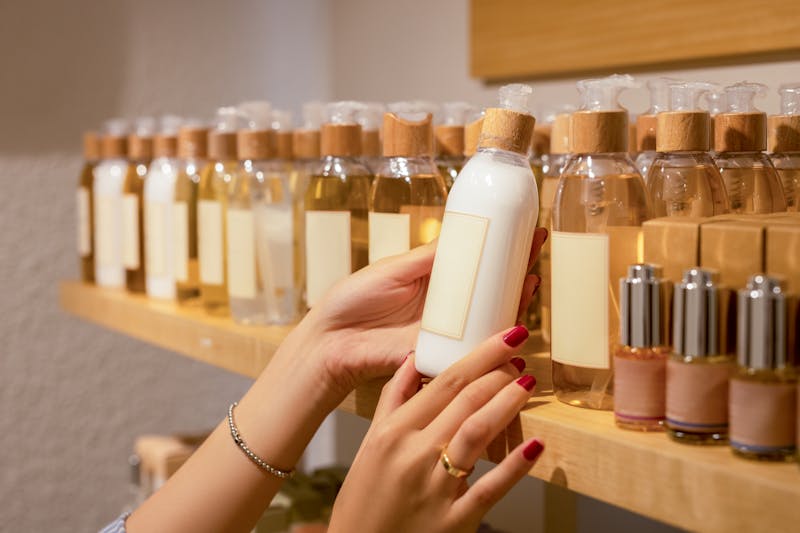
Ever wondered if expensive skincare products are worth their price? Or maybe you’ve invested in a splurge product only to be disappointed. For most, a mix of low, mid, and high-end products is the way to go. Focus less on price, and more on the ingredient range and how it addresses your current skincare needs.
Are you only paying for the brand name?
Generally speaking, you can expect a higher concentration of active ingredients with high-end brands. Sometimes, you’re paying for decades of ongoing research, which is true for many department store brands and luxury brands, including La Prairie and Augustinus Bader.
In some cases, part of what you’re paying for is the brand name. For example, many couture fashion brands sell lipstick or a small makeup collection. You can expect higher quality, but you’re also paying for luxury branding.
Should you use a single skincare collection?
When you find a facial serum, moisturizer, or eye cream that works well, you may be tempted to invest in the full collection. What’s more important is to focus on your current, seasonal, and evolving skincare needs. When you select mid-range or expensive skincare products based on their ingredient range and efficacy, you’re more likely to mix your skincare brands. This includes splurging on some products and saving on others.
For example:
- You might invest in a high-end anti-aging moisturizer that you only use a few days a week as a proactive approach before you develop fine lines.
- Since Arizona winters are dry, you may use a thicker day cream by a luxury brand in the winter months that is scientifically proven to hydrate skin, lock in moisture, and minimize moisture loss throughout the day.
- You may use a high-end moisturizer at night and a mid-range product in the morning. As the signs of aging begin to show, you may upgrade your day cream.
How to know which skincare products will work for you?
Avoid the temptation of purchasing trending products. Instead, build your skincare routine around products formulated for your skin type, skin conditions, and local environment.
#1 Identify your skin type
Select products that are formulated for your skin type. This could be normal, dry, oily, sensitive, or combination. This can change in each season of life. For example, you may struggle more with acne in your teens and early 20s. Or your skin may become dry as perimenopause begins. Collagen production also slows during perimenopause. For many women, hormone replacement therapy has a hydrating, lifting, and firming effect that can’t be achieved with luxury skin products alone.
#2 Identify your skin conditions
Select ingredients that are formulated to address your current skin conditions. Skin conditions may change from winter to summer. Also, as your skin matures. Once you find what works, you’ll need to make changes to your skincare routine at least every 10 years.
Common skin conditions include:
- Acne
- Dehydrated skin
- Dry skin
- Eczema
- Hyperpigmentation
- Mature skin
- Puffy eyes
- Rosacea
#3 Tailor skin care to your local environment
If you move from one city or state to another, you may find that your skincare needs change. Arizona summers are hot and dry, and the winters are cold and dry. So, if you recently moved to the Phoenix area from another state, your skin may feel dry, but it’s likely dehydrated.
Dry skin is a skin type, but dehydration is a skin condition. Dehydrated skin could be a sign of internal dehydration. With our extreme summer heat, you may need to drink more than 64 ounces of water per day to avoid dehydration. In addition to increasing your fluid intake, increase your electrolyte intake and omega fatty acid intake. Externally, transition to skincare products with hyaluronic acid, omega fatty acids, and ingredients that minimize moisture loss.
Are natural skincare products better?
If you’re trying to reduce the chemicals in your diet and skincare products, you may begin to explore brands formulated with 100% natural ingredients. You’ll find that many luxury skincare products are vegan and formulated with natural botanicals. However, they may not be 100% natural. Although not entirely natural, most luxury brands keep chemical ingredients to a minimum. This isn’t only because they’re not environmentally friendly but because many chemicals are harsh on the skin.
When shopping for products without synthetic ingredients, use the same approach above. Shop for your skin type, skin condition, and environment, and don’t limit yourself to one brand.
Try a sample size first
Before you splurge on expensive skincare products, try a sample size. With most products, you may see and feel results in 7 to 10 days, with full benefits at 2 or 3 months. A sample size gives you at least a week to see how your skin responds.
Christmas and Mother’s Day are excellent times to try new skincare products. This is when department store beauty brands, online retailers, and mid-range retailers offer bundles. This allows you to try different serums and night creams. It’s also a good time to try new makeup and haircare products and stock up on products you know and love.
Should expensive skincare products sting or burn?
Generally, skin care products should not sting, burn, or cause irritation. If your skin is dry or irritated, products that don’t typically sting may sting. Most products that cause irritation are too harsh, not for your skin type, or contain ingredients your skin needs time to adjust to.
For example, vitamin C serums formulated with ascorbic acid may cause mild skin irritation. Vitamin C oils formulated from tetrahexyldecyl ascorbate are gentle. However, tetrahexyldecyl ascorbate-based vitamin C products often cost twice the price of ascorbic acid products.
What to do with products that don’t work for you?
We’ve all been there! If you have a facial serum or moisturizer that didn’t work for you, use it on your hands or feet! If the face cream has SPF, pop it in your purse to use as daytime hand cream. Or give it to a friend or family member to try.
When to splurge and when to save on skincare products?
Let’s explore when to shop for expensive skincare products and when to choose low or mid-range.
#1 Anything Condition-Specific: Splurge
Splurge on condition-specific products. Although anti-aging products are mentioned below, you might only splurge on your serum and moisturizer.
Common skin conditions include:
- Acne
- Dehydrated skin
- Dry skin
- Eczema
- Hyperpigmentation
- Mature skin
- Puffy eyes
- Rosacea
#2 Cleanse: Save
Your cleanser is one place you can save. Prioritize gentle formulas that won’t strip your skin. If you wear full makeup, consider double cleansing in the winter to remove your makeup.
#3 Toner: Save
Even if you use a gentle cleanser, it may be slightly acidic. Toner helps to rebalance your skin’s pH levels. Toner neutralizes this acid. Ensure your toner is gentle and alcohol-free.
#4 Facial serum: Splurge
Facial serums are restorative formulas designed to deliver nourishing antioxidants deep into your pores. High-quality and concentrated formulas tend to cost more.
Before the signs of aging begin, you can use anti-aging serums a few days a week as a proactive approach. Or use sheet masks a few days a week. Sheet masks are often cost-effective and formulated to address specific skin conditions.
#5 Moisturizer: Splurge
As your skin matures, expect to pay more for anti-aging formulas.
- In your teens and 20s, over-the-counter products are sufficient for most.
- In your 30s, transition to mid-range products with higher antioxidant levels.
- In your 40s and beyond, prioritize formulas that lift, firm, plump, smooth, and hydrate.
#6 Eye serum and moisturizer: Mid-Range to Splurge
Follow a similar approach to eye serums and moisturizers as you do with skincare moisturizers. Between the blue light of electronic devices and squinting at screens, fine lines can form around the eyes in your early 20s. So, you may transition to mid-range products in your later 20s and expensive skincare products in your 30s.
#7 UV protection: Save or Splurge
Price is less of a factor with UV protection, but there are times you may want to splurge. Ensure your product is broad-spectrum 35, preferably 50. Apply after your facial moisturizer, or facial oil, and before your makeup. If you’re layering products with UV protection, they don’t “add up”. For example, if your facial moisturizer is SPF 25 and your foundation is SPF 15, your SPF protection is 25—not 40.
Your daily moisturizer may have SPF protection built in, but it may not be broad-spectrum, and it may be lower than 35. Your makeup may also have SPF protection. Like your moisturizer, it may not be broad-spectrum and may be lower than 35.
If you don’t wear makeup or prefer light coverage, consider splurging on a UV product with skincare ingredients built-in—such as ISDIN Fusion Water or other ISDIN products.
#8 Exfoliate: Save or Splurge
In your teens, 20s, and 30s, standard granular exfoliators are sufficient. Maybe even silicone exfoliating brushes. By your late 40s, your skin’s natural exfoliating process slows. This is when you want to transition to gentle chemical exfoliators, which cost a bit more.
Look for chemical exfoliators with alpha hydroxy acid, glycolic acid, lactic acid, beta hydroxy acid, or polyhydroxy acids. These are gentle on your skin when used as directed.
#9 Deep Cleansing: Save or Splurge
Deep cleansing mud and clay masks can span the range of inexpensive to mid-range and high-end. Products that cost a bit more are typically infused with ingredients that nourish while they cleanse. Also, consider investing in an at-home facial steamer to use before your clay mask, or before you apply your PM serum and moisturizer.
As skin matures, consider monthly or quarterly deep-cleansing facials.
Beyond your daily skincare treatments
In addition to knowing when to splurge on expensive skincare products, learn which med spa treatments can help you achieve your aesthetic objectives. Valley Medical Weight Loss and Med Spa provides a range of treatments to fade hyperpigmentation, lift, firm, smooth, refine, contour, and plump. We have treatments for your face, jawline, neck, and body!
Schedule a consultation in our Phoenix, Tempe, or Glendale office to learn more!

